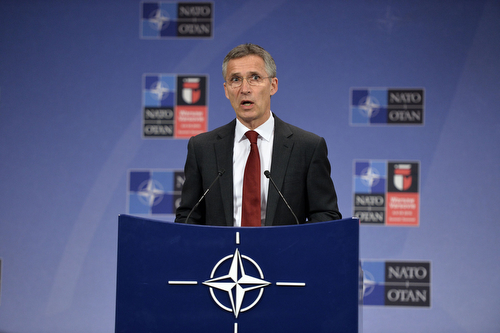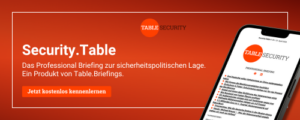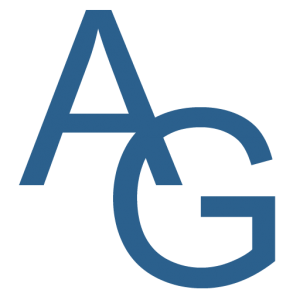Fahrplan für den NATO-Gipfel: Wie angekündigt, nur Russland-Rat später
NATO-Generalsekretär Jens Stoltenberg hat am (heutigen) Montag den Fahrplan für den Gipfel des Bündnisses am kommenden Freitag und Samstag in Warschau vorgestellt. Überraschungen gibt es keine; und jetzt ist auch endgültig klar: Ein weiteres Treffen des NATO-Russland-Rates wird es erst nach dem Gipfel geben.
Ein paar Kernpunkte aus Stoltenbergs Pressekonferenz:
• We will deploy four robust, multinational battalions to Estonia, Latvia, Lithuania and Poland. I welcome Canada’s recent announcement that it will lead one of these four battalions. Together with Germany, the United Kingdom and the United States. (…) We will also agree to develop a tailored presence in the south-east, based on a multinational brigade in Romania.
• We will recognise cyberspace as an operational domain, alongside air, land and sea. And I expect that Allies will make a Cyber Defence Pledge to strengthen their own networks.
• The Warsaw Summit will renew our commitment to spend more on defence and to spend better. (…) Last year, after a long period of decline, we saw a small increase in overall defence spending by NATO’s European Allies and Canada. This year, we estimate that it will rise even more. We expect a real increase of 3% in defence spending by European Allies and Canada.This amounts to 8 billion US dollars. 22 Allies will increase defence spending in real terms.
• The NATO-Russia Council has an important role to play as a forum for dialogue and information exchange, to reduce tensions and increase predictability. That is why we are talking with Russia to hold another meeting of the Council shortly after the Warsaw Summit. Where transparency and risk reduction should be an important topic.
• We will decide that NATO AWACS aircraft will provide information to the Global Coalition to counter ISIL.
• And I expect we will agree on a role for NATO in the Central Mediterranean, complementing the European Union’s Operation Sophia. And building on our effective cooperation in the Aegean to cut lines of human trafficking.
Auf der Tagesordnung steht außerdem die Fortsetzung der Mission in Afghanistan und die engere Zusammenarbeit mit der EU – dass Schweden und Finnland zeitweise bei dem Gipfel dabei sind, ist allerdings nicht nur ihrer EU-Mitgliedschaft geschuldet, sondern vor allem ihrer geographischen Nähe zu Russland.
Die Bundesregierung dürfte sich bei diesem Treffen an ein paar Punkten festlegen müssen: Wie schon angekündigt bei der Enhanced Forward Presence mit der Führung eines Bataillons in Litauen, bei der Zusage für höhere Verteidigungsausgaben sowie bei den geplanten Missions-Ausweitungen mit AWACS für den Kampf gegen die ISIS-Terrormilizen und einer NATO-Rolle im zentralen Mittelmer. Die beiden letzten Punkte könnten dann auch in neue oder ergänzte Mandate für die Bundeswehr-Beteiligung an diesen Einsätzen münden.
Die Videos der Pressekonferenz (erst das Statement, dann der Teil mit den Fragen und Antworten):
(Direktlink: https://youtu.be/Olhf0C56kAc)
(Direktlink: https://youtu.be/3lgwuKJAaZo)
(Weil die Frage gelegentlich kommt: Nein, ich werde nicht zum Gipfel fahren – angesichts der geschätzt mehreren tausend Journalistenkollegen dort ist das für einen Freelancer wie mich, der das ja auch aus eigener Tasche finanzieren muss, nicht wirklich sinnvoll. Aber ich werde natürlich die Ergebnisse beobachten und hier aufgreifen.)
(Foto: Pre-summit press conference by NATO Secretary General Jens Stoltenberg ahead of the NATO Summit in Warsaw on 8 and 9 July 2016 – NATO photo)




Die Agenda, nochmals, bereits am 02.07. in Bällebad gesetzt, hier aber bestimmt richtiger platziert.
http://www.nato.int/cps/en/natohq/news_132786.htm?utm_campaign=160629%2Bsummit%2Bguide&utm_source=twitter&utm_medium=smc
Arte berichtet heute 20:15 zu Gefahren neuer Ost-Westkonflikt von „Vor Ort Baltikum-Polen“.
Mein Estnisch ist nicht besonders gut ( . . .), daher kann ich den Kommentar auch nicht beurteilen aber den Bildern nach scheint es den Zuschauern eher zu gefallen, wenn die US-Warzenschweine ganz praktisch üben.
http://news.postimees.ee/3740411/planes-practised-landing-on-highway
Die Präsenz der alliierten Truppen dürfte also schon dadurch nützlich zu sein, dass sie die Balten davon abehält aus Unsicherheit heraus Dummheiten zu begehen.
„The exercise was cut short after a plane hit a bird……“ Nun setzen die Russen schon Vögel ein als Hybrid Drones /SCNR
Rechtzeitig vor dem Gipfel positioniert sich Obama zu AFG: https://www.whitehouse.gov
„@CanadaNATO: #NATOSummit #Warsaw https://t.co/59Qc2N9KpC
Wichtigster Nach-Wendegipfel vor dem Start.
Exit aus AFG durch OBAMA verlangsamt.
8.400 bleiben auch 2017 verfügbar. Kabul hat sich bereits bedankt. Die andauernden Leistungen der USA dürften in Warschau Forderungen an Bündnispartner ergeben, eigen Beitrag adäquat zu belassen.
Wird unter dem Titel „NATO and Afghanistan“ in Warschau Thema sein. http://thehill.com/policy/defense/overnights/286775-overnight-defense-us-slows-afghan-exit-pentagon-helps-hunt-baghdad
Übelster FrühwahlkRampf.
„@spdbt: BT-Debatte zum #NATOSummit | @ThomasOppermann warnt: „Ein Rüstungswettlauf wäre das Letzte, was #Russland und wir gebrauchen können.““
Oder bedeutet Flagge zeigen, Schutzbelange wahrnehmen „Rüstungswettlauf“.
Der Herr hat zu heiß geduscht, soll bei Helmut Schmidt nachlesen, was Umsetzung von Sicherheit verlangt.
http://www.nato.int/docu/review/2016/Also-in-2016/nuclear-deterrence-alliance-21st-century-nato/EN/
Pünktlich zum Gipfel wird jetzt auch die Nukleare Abschreckung in die Debatte eingeführt, dialogfrei sozusagen:
„Fostering nuclear debate within the Alliance is essential as the dramatic loss of nuclear culture, combined with the limited experience of many Allies, creates imbalances that contrast sharply with potential adversaries. This form of exercising at the political level is important for future crisis management should a crisis occur.
• Emphasising the last resort and deterrent nature of nuclear weapons could be highlighted in direct contrast with the brinkmanship postures sometimes adopted by potential adversaries. NATO should also underscore that all Allies continue to honour their international obligations and commitments, including on nuclear weapons. …..“
Nukleare Kultur ? Lieber Himmel, das kann nur ein Franzose schreiben……
@Klaus-Peter Kaikowsky
Klar ist das Wahlkampf, aber nicht so wie Sie das vielleicht meinen. Das ist der klassische „running voter fishing in the margins contest“. Die SPD fischt eben am linken Rand und die CDU/CSU am rechten Rand, also der gute, alte GroKo-Wählerfang.
Das Obama-Statement zu Afghanistan ist schon ganz interessant:
O. listet nur Al Quaida und ISIL als security threat to the US, aber nicht die Taliban. Und dann macht er die klassische „split-the-difference“-Ankündigung, indem er – zwischen der militärischen Forderung des DoD von 10.000 US und seinem Abzugsplanungsziel für 2016/17 von ca. 5-6000 Mann – nun einfach „mittelt“. Klassische US-Innenpolitik ;-)
Auf die NATO sehe ich da keine zusätzlichen Forderungen zukommen und die Verlängerung des Einsatzes inkl. leichte Aufstockung des deutschen Kontingentes ist ja schon durch. Afghanistan wird beim Gipfel imho nur ein Randthema sein.
Gipfel-Countdown nimmt Fahrt auf.
http://www.nato.int/cps/en/natohq/news_133170.htm?utm_campaign=summit_countdown&utm_source=twitter&utm_medium=smc
Was hier dabei weitgehend unbeachtet blieb, weil ist ja so weit weg: A multinational framework brigade in Romania will provide a tailored presence in south-eastern Europe.
Breedlove bekam gestern übrigens eine der höchsten POL Auszeichnungen verliehen. Warschau legt sich medial mächtig uns Zeug.
@klabautermann
Leuchtet mir schon alles ein. Nur provoziert eine Mobilisierung im linken Spektrum, falls überhaupt noch steigerbar, Antiamerikanismus sowie ff den Blick nach „richtig“ links. Wer seine anti-Washington Haltung im Wahllokal umzusetzen gedenkt, macht das Kreuzchen sicher mehrheitlich bei Frau Wagenknecht. Und wäre diese Klientel nicht eher Fleisch vom Fleisch der SPD?
Angela Merkel in ihrer Regierungserklärung am Morgen zum Gipfel: “ …. werden das 2%-Ziel (bei Verteidigungsausgaben) schrittweise erreichen …“.
So eindeutig aus dem Munde der Kanzlerin, im Plenum, war das bislang nicht zu vernehmen.
Lässt hoffen, bei diversen RüProj (in the long run), hier auch immer wieder erörtert.
„@petertauber: Die NATO tagt in dem Saal, in dem der Warschauer Pakt gegründet wurde. Starkes Symbol für den Sieg der Freiheit über den Sozialismus.“
Herrliche Symbolik der Nachhaltigkeit von Idealen der Freiheit.
Die vier symbolischen vstkBtl/GefVbd wird der Zar als mehr als dies verstehen, sicher.
For the Record:
Die „Steering Group of Veteran Intelligence Professionals for Sanity“ hat (mal wieder) ein Memorandum an Frau Merkel geschickt. Das geht natürlich völlig im üblichen pre-summit-PR-mainstream-shitstorm unter – deshalb hier der link:
https://consortiumnews.com/2016/07/06/merkel-urged-to-temper-natos-belligerence/
Die Sicht dieser US-amerikaniscen Sanity-Checker ist nicht nur lesenswert, sondern imho bedenkenswert.
@Klabautermann
They’ve got a point, wie die Amis sagen würden. Obwohl ich die Argumentation teilweise nicht ganz sauber finde – mit der Aussage We believe Foreign Minister Frank-Walter Steinmeier was correct to point out that military posturing on Russia’s borders will bring less regional security ignorieren sie wie die meisten in den Mainstream-Medien, dass Steinmeier die Beschlüsse zur Reassurance in seinem Text ausdrücklich bekräftigt hat – neben der Warnung vor Säbelrasseln…
@T.W.
Zustimmung. However, Steinmeier hat zwar reassurance bekräftigt, aber mit seiner „Säbelrassel“-Metapher vor einer übertriebenen deterrence-posture/rhetoric letztendlich gewarnt – genau wie die sanity-checker ;-)
Letztendlich ist dieses Memo an Merkel doch nur Ausdruck der Hoffnung der Autoren, dass Frau Merkel sich nicht durch die „US-Cowboys“ in Sachen Rußland treiben lassen soll wie Obama – mit anderen Worten, sie sollte es nicht zulassen, dass die US-Reassurance-Initiative zum Treiber einer NATO-Deterrence-Posture wird wie weiland im Kalten Krieg.
Siehe auch auf WELT Michael Stürmer, „Wer mit Russland redet, sollte es auch verstehen“:
„…..Der Westen hat, fast ohne es zu wollen, den Kalten Krieg für sich entschieden. Seitdem aber ist er dabei, unter Führung der Vereinigten Staaten den kalten Frieden zu verlieren….“